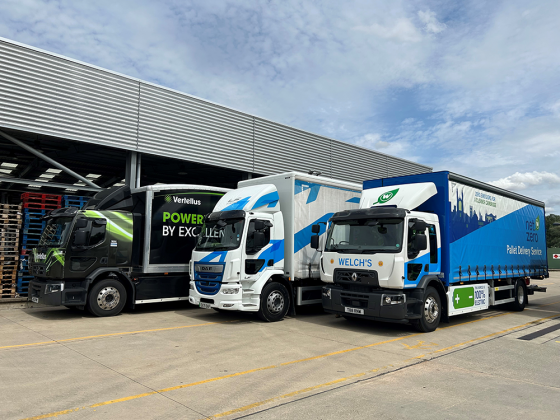GreenFleet Commercial Vehicle Roundtable

The way commercial vehicles are powered in the future is likely to be very mixed – with no single alternative fuel acting as the ‘silver bullet’. This was the message that came out of GreenFleet’s Commercial Vehicle Roundtable, which took place on 23 March at London’s iconic Tower Bridge
Commercial vehicles are the UK’s workforce, delivering vital goods and providing services for the country. Above anything else therefore, the vehicles have to be fit-for-purpose. So while the appetite to reduce emissions from commercial vehicle operations is there, if the greener alternative is not viable, it will not be used.
While electric vehicles work for some, they don’t for others. The same can be said for hydrogen and gas. Meanwhile Euro VI diesel still remains the most viable option for many. So we are looking at a very mixed-fuel future, where a range of alternative fuels and powertrains will exist side-by-side to power the industry.
This was the consensus from delegates at GreenFleet’s Commercial Vehicle Roundtable on 23 March. Sponsored by green truck manufacturer Tevva Motors and leasing firm Leaseplan, the roundtable hosted representatives from various commercial vehicle operators, including logistics firms, emergency services, airports, councils and healthcare organisations.
Representatives from the gas, electric and hydrogen industries were also present, alongside a spokesperson for FORS – the Fleet Operators Recognition Scheme. The discussion was chaired by motoring journalist John Curtis.
With such a broad range of organisations represented at the table, all with very different operational requirements, it was clear that a mixed approach to alternative fuels will work best.
“Diesel has been the answer for the last thirty to forty years, but the future looks like its going to be far more mixed,” commented Rob Wood, CEO of Gas Rec. “The UK has a mixed fleet and so it will need mixed technologies.”
But there are still many challenges to overcome first before the mass‑adoption of greener fuels can occur in the sector, delegates agreed.
Overcoming electric concerns
With regards to electric vehicle technology, there were concerns around the table over the range of the vehicles, the refuelling infrastructure, the cost, and the lack of skilled support, training and maintenance services after sale. And many in the room had been let down by immature electric vehicle technology in the past.
David Thackray, sales and marketing director for Tevva Motors, a company that makes range-extended electric trucks, explained how EV technology has moved on since the early few vehicles.
He said “There’s an old adage that says the early bird catches the worm, but this is not the case for early electric vehicles, as many of the first EVs were not fit-for-purpose. But technology is clearly maturing nicely, with batteries and motors getting better.”
David went on to say that while the options are not vast, they do exist and more will come in the imminent future. He said “As well as Tevva’s range-extended electric trucks, which come in 7 to 14 tonnes, other viable alternatives are emerging, such as the recently launched electric Fuso eCanter. Meanwhile Volvo has announced they will launch an electric truck at the IAA show in Hannover in September.”
Applauding progress
Amanda Lyne, chair of the UK Hydrogen and Fuel Cell Association, and managing director of Ulemco, raised the point that there should not be an obsession with zero emission at this time, because “the danger of doing ‘all or nothing’ is that you don’t do anything.” Given the limited zero-emission alternatives for commercial vehicles, making a percentage improvement should be applauded, whether that’s using ultra-low emission vehicles, or only using zero-emission vehicles in certain operations where it is viable, Amanda believes.
Iqbal Gill, procurement manager at Heathrow Airport, echoed this thought, saying that in the airport they operate a mix of electric and plug-in hybrid vehicles (PHEVs). “The PHEVs are doing 30 to 40 miles a day, and while it’s not zero‑emission, it is a better option,” he said.
Also in agreement, Rob Wood said: “There are choices out there, but not all are zero emission. If you accept that emission reduction is a good thing, then you open up a different set of options that are practical.”
Sharing his experience of managing customers’ expectations on where electric vehicles will or won’t work, Mark Lovett, commercial vehicle specialist at Leaseplan, said: “Once we have sat down with customers and had a proper understanding about how they use their vehicles, we might say, ‘actually electric is not going to be right for that particular vehicle or division, but it would work in that one’.
“We’ve seen some customers giving up on the idea that they need to change 50 per cent of their fleet to electric, but are happy with ten or 15 per cent because that is what’s realistic. It is still a great improvement and one that should be commended.”
Mark continued: “The fit-for-purpose element is crucial when it comes to alternatively‑fuelled vehicles. We have a client that uses electric vans, doing 50 miles in and out of London. That particular vehicle application is perfect for them – saving on congestion charging, fuel, repair and maintenance. But as soon as you start to deviate from that ‘perfect scenario’, EVs become more of a challenge.”
Georgina Smith, fleet manager at Healthcare at Home explained how it is crucial for the EVs to be fit-for-purpose in her organisation. Healthcare at Home delivers high value medication to patients in home. It is a national company with 160,000 patients.
The fleet comprises 450 cars and 170 dual temperature LCVs that need to have a continuous supply of electricity for the medication. After two years of work analysing the business, 23 drivers have been highlighted as suitable for electric driving. While this is a small percentage, it is still a step in the right direction and one that will still make a significant impact on emission reduction, the group agreed.
Heavy goods
There was a general consensus round the table that for heavy goods vehicles, it is hard to find an alternative to diesel. Gas vehicles stand out as a possibility, and Rob Wood spoke about a trial that the Department for Transport is doing with Innovate UK to test the latest gas vehicles in Millbrook and compare them back-to-back with diesel to get true answers about their performance.
Taking the conversation to biodiesel, Norman Harding, corporate fleet manager at the London Borough of Hackney, spoke about the work he is doing with hydro‑treated vegetable oil (HVO). He said: “We’ve just started doing formal emissions testing on HVO at Millbrook.
The first test we did, based on a multi-drop parcel delivery round, got 69 per cent NOx reduction at the tail pipe and an 11 per cent carbon dioxide reduction. It is made from used cooking oil so it is already inherently carbon efficient.”
Norman is so convinced on the effectiveness of HVO that he said: “Where I can’t use electric power for my vehicles, I will be looking to use HVO and we could be emissions free in 18 months time.”
Lack of training and support
Another issue that came up during the roundtable discussion was the lack of training, support, and maintenance for new vehicle technologies and fuels.
Rob Ellis, divisional fleet and plant manager at Ringway said: “As technology changes, unless your service provider is up-to-date, you can have issues with support and maintenance down the line.”
Pointing to a wider issue, Graham Tillett, head of fleet at British Transport Police said that there is not enough of the right type of people coming into the industry, with the expertise to deal with modern vehicles. He said: “We have it all the time – whether it’s a problem with an EV or just diagnosing a fault, if the computer doesn’t tell the engineers what the problem is – everyone is scratching their heads.”
Chris Dixon, transport and plant operations manager at Eurasia UK explained the problem he has in getting any training from the EV manufacturer for the company’s ten electric vehicles on the Isle of White.
Norman Harding has also experienced this problem, saying he has been told that EVs are “too high voltage” as an excuse for not providing training. “You have to get it written into tender process that the dealer will provide training to the appropriate standard,” Norman advised.
David Thackray explained how they deal with maintenance at Tevva Motors. He said: “We’ve designed the system in a modular fashion, so that if there is a problem with the batteries, it can be sorted in 45 mins, likewise with the motors or generators. So the vehicle downtime is low.”
David also explained how the vehicles can be monitored remotely to prevent failures happening in the first place. He said: “We can monitor the temperature of the battery and motor, for example, and if we see things moving out of design parameters, we can call the client up and sort the problem, if there is one. You don’t have to wait for a failure.”
To sum up discussions, event chair John Curtis raised some questions. He said: “Round the table there is lot of knowledge and experience of alternative fuels that can work on a genuine operational cycle. But how do we share that message across businesses effectively? And how do we use our knowledge and experience
to shape policy?”






